Great Pyrenees and Standard Poodle: Pyredoodle Dog Breed Information
The Pyredoodle is a mixed breed dog that brings together the best traits of the Great Pyrenees and the Standard Poodle. This intelligent breed, known for its friendly nature, is a beautiful addition to large families and fits in very well, especially when visiting places like the dog park.
Pyredoodles, a designer breed, have a soft, hypoallergenic coat that doesn’t shed much, making them an excellent choice for dog owners with allergies. Belonging to the category of large dog breeds, Pyredoodles require a lot of space for movement and regular trips to the dog park to exercise and maintain their health. These intelligent dogs, the Pyredoodles, grasp training commands quickly, thus making the training process smoother.
However, remember to regularly take your dog to the vet or a professional groomer to keep their coat in good shape. For those who can provide the spacious environment and care they need – like regular visits to the dog park and the vet – a Pyredoodle makes a loyal and loving companion amongst large dog breeds.
Key Takeaways
- Pyredoodles are affectionate hybrids of Great Pyrenees and Poodles.
- Their low-shedding coats are beneficial for allergy-prone individuals.
- Spacious living and consistent grooming are key for their wellbeing.
Quick Facts
The Pyredoodle is a hybrid breed, crossing the Great Pyrenees with the Standard Poodle, known for its hypoallergenic coat and friendly nature that makes it an excellent fit for families.
Standing between 22 and 28 inches in height and weighing around 40 and 100 pounds, the Pyredoodle is a sizable dog that inherits the sturdy frame of the Great Pyrenees and the sophisticated genetics of the Poodle.
This crossbreed sports a curly or wavy coat that’s less likely to trigger allergies, making it an ideal pet for those with sensitivities. The mix of the two intelligent breeds means the Pyredoodle tends to be easy to train and can quickly adapt to various environments.
Owners should regularly monitor their health, as their larger size can predispose them to specific conditions common in big dogs.Pyredoodle Pictures



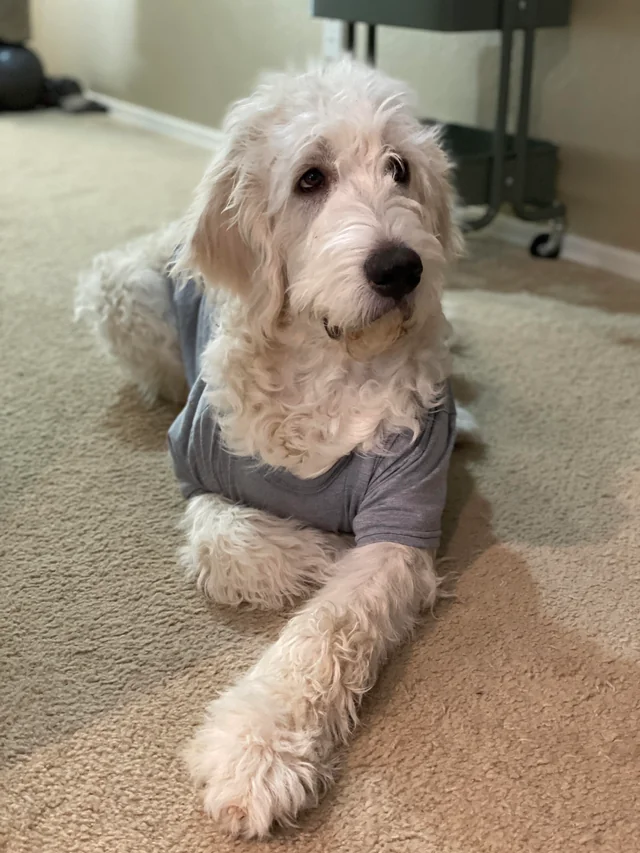
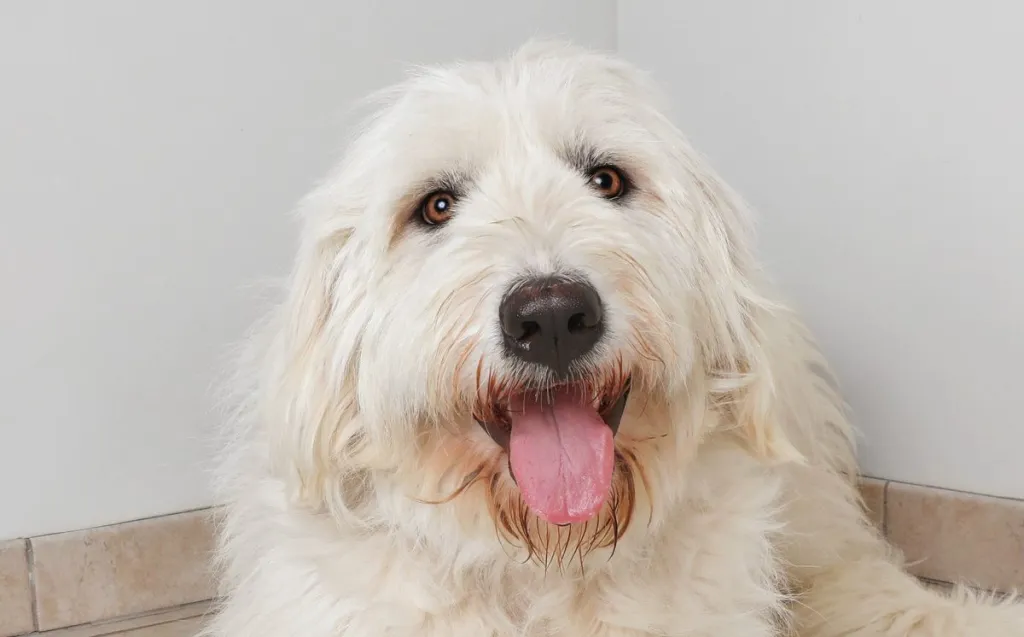

Overview
The Pyredoodle is a mixed breed that combines the best traits of its parents: the strong Great Pyrenees and the intelligent Poodle.
This dog often has the Poodle’s allergy-friendly coat and the Great Pyrenees’ instinct to guard, making it a loyal and protective pet with a gentle nature.
Regular grooming is necessary to keep their fur free from tangles, and it’s also wise to be alert to any health issues they may inherit.
Getting pet insurance might be a good idea to help with unexpected vet bills.
Key Breed Traits of Pyredoodles
The Pyredoodle, a mix of the Great Pyrenees and Standard Poodle, stands out due to its large size, low-shedding coat, and warm, protective nature. These dogs combine the strength and watchfulness of the Great Pyrenees with the Poodle’s low-allergen skin and sharp mind. Known for their smartness and ease of training, Pyredoodles excel in roles such as assistance and therapy animals. Their calm demeanor and friendliness toward children make them excellent family pets.
| Trait | Description |
|---|---|
| Coat | Low-allergen, curly or wavy, needs consistent grooming |
| Temperament | Caring, watchful, intelligent, and easy to train |
| Compatibility | Works well with kids and other animals, versatile in different home environments |
Breed Origins of Great Pyrenees and Standard Poodle

The Pyredoodle is a crossbreed designed to blend the best traits of its parent breeds, the Poodle and the Great Pyrenees. The goal was to combine the Poodle’s allergy-friendly coat with the Great Pyrenees’ instinct to guard. This mix aimed to produce a dog that sheds less, making it a great companion for those with allergies.
The breeders also wanted an intelligent and trainable dog that could excel as a service animal and a loyal family member. The Pyredoodle has become a well-rounded breed that meets these needs through careful selection and breeding.
Parent Breeds Combination
The Pyredoodle is a hybrid breed from a mix of the Great Pyrenees and the Standard Poodle. Originating in the Pyrenees Mountains, the Great Pyrenees is known for its role in guarding livestock, while the Standard Poodle, developed in Germany, is praised for its intelligence and agility.
When these two breeds are combined, the resulting Pyredoodle inherits the Great Pyrenees’ protective nature and solid build, along with the Poodle’s allergy-friendly coat that sheds less.
Breeders focus on merging the best qualities of the Great Pyrenees and the Poodle, aiming for puppies that show a good mix of personality, physical attributes, and low-shedding fur. Typically, a Pyredoodle will display the strength and watchful traits ideal for protection, as well as the intelligent and active features characteristic of the Poodle family.
Historical Development
The Pyredoodle is a hybrid breed that began to take shape in the United States, emerging sometime between the 1980s and early 2000s. Dog breeders aimed to marry the best qualities of the Great Pyrenees and the Standard Poodle.
They sought to combine the Great Pyrenees’ guarding abilities and impressive size with the Poodle’s allergy-friendly coat and intelligence.
While the American Kennel Club has yet to recognize the Pyredoodle officially, this mix has gained popularity thanks to its distinguished lineage and versatility to dog lovers.
Originating Purpose
The Pyredoodle came from mixing the Great Pyrenees with the Standard Poodle, aimed at creating a dog that was both a great companion and valuable, especially for those needing a protective but allergy-friendly pet. This new breed combined the Great Pyrenees’ natural protective instincts with the Poodle’s smartness and low-shedding coat, resulting in a bright, alert, and affectionate pet.
Breeders focused on reinforcing these qualities to ensure the Pyredoodle could adapt well to different homes and form tight bonds with its owners.
Physical Dimensions
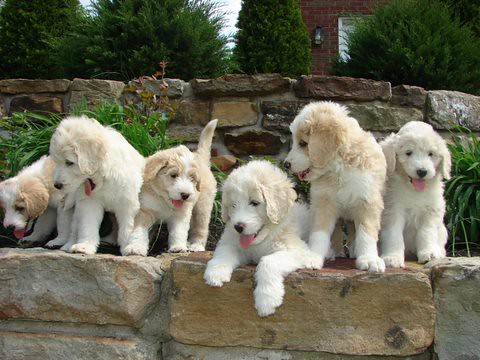
Their size and weight are key factors when considering a Pyredoodle as a pet. They vary in height, standing at the shoulder from 22 to 32 inches tall. As for weight, they can be pretty light at 40 pounds or heftier at 100 pounds.
The height of a Pyredoodle will give you a good idea of how much space they’ll need in your home. Their coat length is another aspect to consider, as it affects how much time you’ll spend grooming them and can also influence allergy concerns.
These details are more than just numbers; they’re vital for understanding what to expect in terms of living space, care needs, and the overall health of your Pyredoodle. Potential owners should carefully evaluate these aspects to make a well-informed decision.
Breed Size Variability
The size of a Pyredoodle can vary significantly due to the differing lengths of its parent breeds, the Great Pyrenees and the Poodle. Some Pyredoodles may be smaller like their Poodle parent, while others may have the larger stature of the Great Pyrenees. This mix means Pyredoodles can adapt to various living spaces, from apartments to houses with yards.
These dogs can thrive in less spacious homes with the proper training and regular exercise. Despite the range in size, Pyredoodles typically maintain a strong and sturdy build, a trait inherited from their impressive ancestors.
Weight Range
Pyredoodles are large dogs, typically weighing 40 to 100 pounds and standing 22 to 28 inches tall. They come from the Great Pyrenees and the Poodle, accounting for their wide range in size.
These dogs have a solid build and are prone to gaining weight quickly, so owners must watch their food intake to avoid obesity-related health issues.
A Pyredoodle’s weight gain is quick early on, with an average puppy reaching around 55 pounds by the six-month mark, and then it slows down, usually hitting about 80 pounds by the age of 18 months. However, each dog’s growth can vary due to its unique genetics and living conditions.
Height Measurements
Pyredoodles vary in height due to their mixed heritage, with standard ones growing to between 26 and 32 inches tall at the shoulder, while smaller versions max out around 24 inches. The cross between the Great Pyrenees and Poodle brings together different size traits, resulting in this range.
Tracking their growth is vital for those raising or caring for a Pyredoodle. It helps to ensure they’re healthy, have enough space, and get the right amount of exercise.
Coat Length Considerations
When looking at a Pyredoodle’s size, it’s clear that their coat length varies a lot. They might have short curls or long waves.
Because they often have a dense double coat, it’s necessary to know this affects their body temperature and skin condition. Pyredoodle owners should plan for regular grooming to keep the coat in good shape and looking nice. A skilled groomer can set up a schedule to prevent tangles and ensure the skin doesn’t restrict the dog’s movement or cause it to get too hot.
For daily care, a slicker brush is advised to gently untangle the hair and remove shed fur, helping keep the coat functional and attractive.
Growth Chart Expectations
Prospective Pyredoodle owners should know what to expect regarding their pet’s growth. A Pyredoodle, a mix between Great Pyrenees and Poodles, grows large.
By six months, these puppies generally reach 15 inches tall and weigh around 55 pounds.
When they hit one year, they are typically about 20 inches tall, and their weight increases to around 77.5 pounds.
They keep growing until about 18 months of age when they tend to reach their full size at approximately 23 inches tall and weigh about 80 pounds.
Knowing these milestones helps owners provide the proper nutrition and care for their dogs’ needs as they grow.
Behavioral Traits
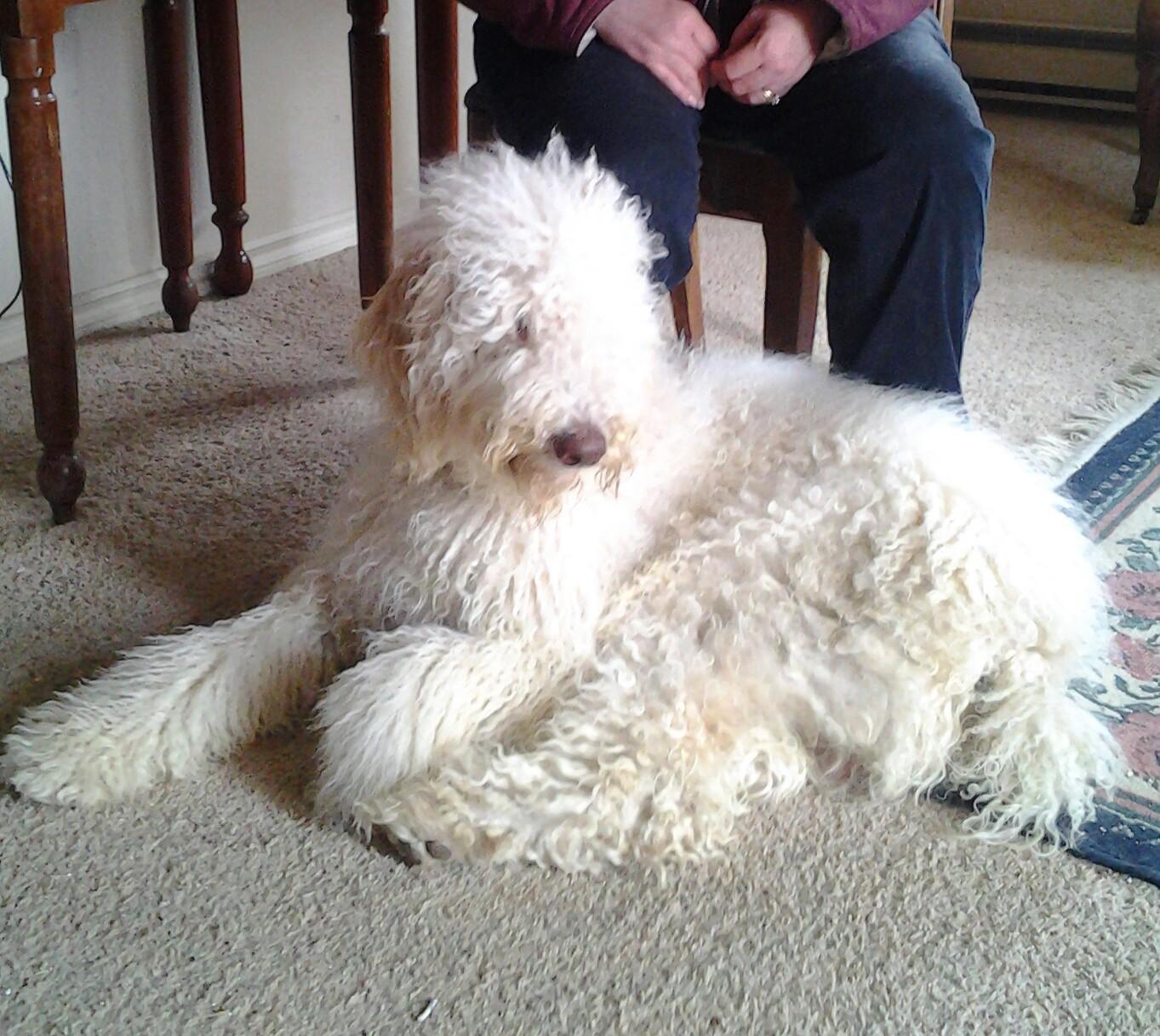
When looking into Pyredoodles’ behavior, it’s vital to consider their complex temperament and the factors that shape their actions. We’ll examine their inherent personality traits, which shape how they interact with people and other animals. We’ll also discuss the unique challenges during training due to their distinct cognitive and emotional makeup.
Consistent socialization from a young age is vital for Pyredoodles to grow into well-adjusted adult dogs. It’s also essential to have strategies for managing their natural prey drive, especially in homes with multiple pets or when outdoors. These strategies prevent unwanted chasing or aggressive actions towards smaller animals.
Understanding these aspects is fundamental for nurturing a well-rounded and pleasant Pyredoodle.
Temperament Traits
Pyredoodles are known for their loving and patient nature, which makes them perfect for families with kids and other pets. Despite their large size, these dogs are incredibly gentle giant and caring, which is why they’re often found in homes with little ones.
They’re also smart and pick up on training quickly, especially when positive reinforcement is used. However, their smarts can lead to stubbornness, so keeping their training engaging and challenging is essential to ensure they stay well-behaved and happy pets.
Training Challenges
Pyredoodles are intelligent and protective, traits that make training them a bit tricky.
Early socialization is crucial in positively shaping their behavior and avoiding the potential issues their guard dog instincts might cause.
It’s critical to use positive reinforcement consistently to instill good habits.
Keeping them physically active and mentally engaged helps make the most of their trainability.
A thoughtful training plan that focuses on patience and routine will help manage the stubborn streak of a Pyredoodle effectively.
Socialization Requirements
Socializing a Pyredoodle properly is critical to making the most of their natural protective instincts and ensuring they grow up to be well-behaved companions. Bringing them into different settings and introducing them to various people, especially kids, helps bring out their friendly and patient nature. These steps are vital for a Pyredoodle to become an excellent addition to any family, getting along well with everyone.
For Pyredoodles, regular exercise is also essential, as it helps manage their energy levels and prevents any negative behavior from surfacing. Engaging them in structured play and learning activities keeps their minds active and encourages good conduct.
A thought-out socialization plan is critical to preventing stubborn tendencies and nurturing their calm and amiable qualities, ensuring they become beloved, protective family members.
Prey Drive Management
Training a Pyredoodle to manage their prey drive is essential due to their instincts. These dogs have a lineage that includes the Great Pyrenees, a breed known for its guarding behavior, which can lead to a strong desire to chase smaller animals. To keep this under control, it’s vital to start obedience training early, focusing on commands such as ‘leave it’ and ‘come.’ These instructions help prevent unwanted chasing.
Pyredoodles are energetic and need plenty of exercise and activities to keep their minds sharp and prevent them from acting on their prey drive inappropriately.
When handled properly, these dogs can be wonderful and well-behaved family members.
Anxiety Signs
Pyredoodles might show signs of anxiety through excessive barking, restlessness, and chewing on things they shouldn’t. These dogs are naturally protective due to their Great Pyrenees heritage, which can lead them to act anxiously if they sense danger.
Their sharp minds need regular mental challenges; without them, they may start displaying anxious behaviors. Early spotting these behaviors is critical to preventing them from becoming more severe health problems.
To help them, using gradual exposure to stressors and positive reinforcement is effective in keeping their protective nature from becoming harmful stress.
Common Health Concerns
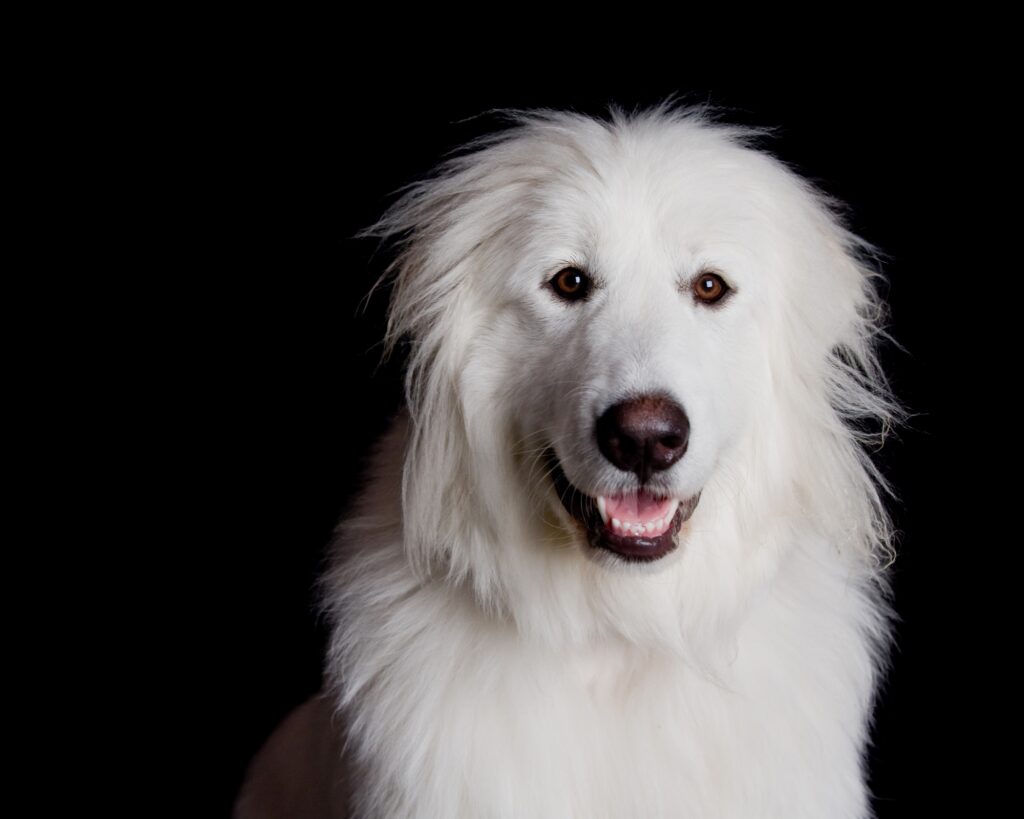
Pyredoodles, known for their friendly demeanor and smarts, have specific health issues that owners should watch for.
- Hip dysplasia is a condition for these dogs, so early check-ups and preventive measures are beneficial.
- Awareness of bloat is critical, as knowing how to prevent it and recognizing the symptoms can save your pet’s life.
- Keeping your Pyredoodle well-groomed is more than just about looks; it’s vital for preventing skin infections.
- Stay alert for signs of common diseases like hypothyroidism. Catching these issues early can significantly affect your dog’s health and comfort.
Hip Dysplasia Risks
Hip dysplasia is a common concern in Pyredoodles, requiring careful observation and proactive health measures for these dogs’ well-being. This crossbreed inherits the possibility of hip dysplasia—a condition where the hip joint doesn’t form correctly—leading to discomfort and trouble moving. Pyredoodles can inherit health issues from their ancestors, and hip dysplasia is a condition that stands out due to its impact on the dogs’ comfort and activity levels.
This disorder causes the hip joint to be loose, which may lead to arthritis and muscle loss over time, resulting in different pain levels. Roughly 15% of dogs may experience this issue. To manage this effectively, regular vet check-ups to spot early symptoms are advised, along with a careful plan that includes managing the dog’s weight, suitable exercise, and a diet that supports joint health.
Bloat Prevention Tips
Bloat is a common health concern for Pyredoodles, but you can minimize the danger with a few essential practices. This condition happens when a dog’s stomach fills with gas and may twist, which is an urgent medical issue.
Feed your Pyredoodle set amounts of food regularly and avoid free-feeding throughout the day to reduce the risk. Choosing a diet recommended by your vet and keeping treats to a minimum helps maintain a healthy weight, which is vital in preventing bloat.
After meals, give your dog a break to digest before any physical activity. Keeping an eye out for bloat symptoms and getting timely vet help is essential for your pet’s health.
Consistent feeding schedules, closely monitoring your dog’s weight and knowing the warning signs of bloating can save lives. Remember, a healthy diet and controlled exercise are your best defenses against this severe condition.
Grooming for Health
Grooming your Pyredoodle consistently is vital for their well-being and spotting potential health issues like skin conditions or bugs. Although their coat sheds less, which is excellent for people with allergies, they tend to gather loose fur and dirt. That’s why daily grooming is vital to keep their coat in shape.
Using the proper grooming tools, like a good brush or comb, is a must for getting rid of knots and preventing skin problems. Regular brushing spreads the dog’s natural oils, giving their fur a healthy shine and keeping their skin from drying out.
During grooming, you also check their skin for anything unusual so you can get help from a vet if you find anything worrying.
Maintenance Essentials
Caring for a Pyredoodle includes a routine focused on their thick coat and overall well-being. Regular brushing a few times weekly is critical to preventing their skin from tangling and matting.
It’s also vital to determine how often your Pyredoodle needs a bath to keep their skin healthy without stripping away beneficial oils. Nail trimming should be done routinely to prevent discomfort and potential mobility issues.
Dental health is non-negotiable; consistent teeth brushing and periodic professional cleanings fend off gum diseases and contribute to your dog’s overall health.
Grooming Routine
Taking care of a Pyredoodle’s coat is essential for their health and comfort. Regular brushing a few times a week is necessary to keep their thick fur free of knots and mats. These dogs have a unique coat that doesn’t shed much, making them suitable for people with allergies, but this also means they need consistent care to stay healthy.
Please pay attention to areas that mat easily, like under their legs and behind their ears, as these spots can trap moisture and debris. Active Pyredoodles can get quite dirty during play, so routine grooming is vital to keeping their skin free from issues and their appearance tidy. Proper grooming supports their physical health and helps to prevent skin conditions.
Coat Brushing Frequency
Pyredoodles need their coats brushed every two weeks to keep their hypoallergenic, low-shedding fur in good condition and to prevent mats. Regular grooming supports the breed’s allergy-friendly qualities, which benefits people with pet dander allergies. Thanks to their Poodle ancestors, Pyredoodles have thick fur that requires consistent detangling to avoid knots.
Brushing does more than remove loose hair and potential allergens; it also invigorates the skin, encouraging the growth of healthy fur and the even spread of natural oils. A comprehensive grooming routine also involves checking the dog for skin issues or parasites, which could harm their coat and health.
It’s advisable to watch for these problems to ensure your dog stays happy and healthy.
Bathing Schedule
Washing your Pyredoodle every 6 to 8 weeks is critical to keeping their coat healthy and maintaining hypoallergenic qualities. A regular bath removes dirt, dander, and excess oils that can build up, which is essential for dogs in families with allergy concerns.
Along with proper nutrition to nourish their coat from the inside, regular grooming helps to prevent skin issues and supports the overall health of these dogs.
Nail Trimming
Keeping your Pyredoodle’s nails short is critical to their comfort and ability to move freely. This mixed breed, a combination of the Great Pyrenees and a Poodle, has a muscular build and needs consistent physical upkeep. If their nails get too long, it can cause foot problems and pain, affecting their ability to stay active.
Starting nail trimming early with Pyredoodle puppies can help them get used to the process and reduce stress during grooming. Clipping the nails correctly is critical to avoid cutting them quickly, which can lead to bleeding and possible infections.
Proper nail care is essential for keeping your Pyredoodle’s paws in good shape for daily walks and playtime.
Dental Care Needs
Good dental care is crucial for a Pyredoodle’s overall health, mainly because they might be prone to particular health issues. Being proactive about their oral hygiene can help prevent serious problems.
Feeding them dog food, promoting dental health, and regularly brushing their teeth can significantly reduce plaque and tartar.
It’s also wise to talk to a trusted breeder to learn about any hereditary dental issues this breed might face.
Regular dental check-ups are vital for spotting and treating gum disease early on, ensuring your Pyredoodle stays happy and healthy.
Dietary Requirements: Best Dog Food
When planning meals for Pyredoodles, choosing nutrient-rich foods that cater to their specific dietary needs is critical. Controlling portions is essential to keep Pyredoodles at a healthy weight and avoid obesity-related problems. Careful monitoring of food quality, serving size, and allergy triggers is critical to the health and happiness of these dogs.
To prevent allergic reactions, it’s also vital to identify and remove any allergens from their meals.
Optimal Food Choices
Choosing the proper diet for your Pyredoodle prevents illness and keeps them healthy. Their meals should be protein-rich to sustain their muscles and keep them energetic.
To lower the chance of bloat, when a dog’s stomach fills with gas and can twist, it’s better to feed them smaller portions multiple times a day, around two to three times. Sticking to a regular feeding schedule can help your dog eat slowly and reduce the risk of bloat.
Portion control is also vital to avoid overfeeding and the risk of obesity. The perfect portion size depends on the dog’s age, size, and how active they are. For the best advice, check with your vet for a diet plan that suits your Pyredoodle.
Managing Allergies
When managing allergies in Pyredoodles, partnering with a vet is vital to figuring out which foods might be causing issues.
Pyredoodles, a mix of the hypoallergenic Poodle and the Great Pyrenees, are generally allergy-friendly but can have food sensitivities.
Through a systematic process of elimination diets, owners can identify harmful ingredients. After finding the culprits, a specialized diet should be set up.
This diet must cater to the needs of large breeds and be rich in protein while excluding allergy-inducing elements.
Staying true to a diet that avoids known allergens is vital for your Pyredoodle’s health and happiness.
Portion Control Importance
Controlling food portions is vital to keeping Pyredoodles healthy and preventing overfeeding. This mixed breed can inherit health problems like bloat, cancer, and hypothyroidism, making a well-managed diet essential.
Measuring food carefully helps prevent weight issues, which can worsen these health risks. Pyredoodles are energetic dogs, so they need a diet that supports their activity levels without going overboard on calories.
Regularly checking the amount they eat, along with advice from a vet, is crucial to maintain their overall well-being.

